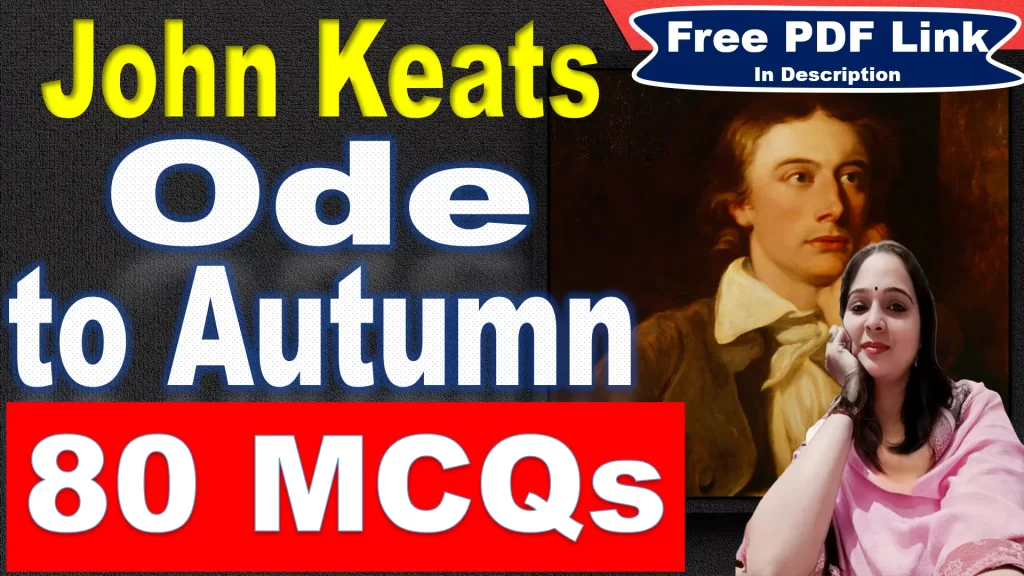
61. What literary device is used in the phrase “barred clouds bloom”?
A) Onomatopoeia
B) Metaphor
C) Symbolism
D) Irony
Answer: B) Metaphor
Explanation: A metaphor is a direct comparison without using “like” or “as”. Here, clouds are metaphorically compared to blooming flowers, creating a soft, poetic image of the sky at sunset. This metaphor beautifies the passing of the day, reinforcing the idea that even endings can be graceful. The phrase highlights nature’s harmony, showing how even clouds can be part of the cycle of life.
62. The phrase “hedge-crickets sing” is an example of which literary device?
A) Alliteration
B) Metaphor
C) Personification
D) Hyperbole
Answer: C) Personification
Explanation: Personification gives human actions to non-human objects or creatures. Crickets do not “sing” like humans, but Keats describes their chirping as a song. This adds musicality to the poem and makes autumn’s sounds feel alive and intentional. By portraying nature as an active participant, Keats enhances the theme that every season has its own beauty and rhythm.
63. Which famous line opens the poem Ode to Autumn?
A) “Season of mists and mellow fruitfulness”
B) “Where are the songs of Spring? Ay, Where are they?”
C) “A thing of beauty is a joy forever”
D) “Thou still unravish’d bride of quietness”
Answer: A) “Season of mists and mellow fruitfulness”
Explanation: This opening line immediately sets the calm and rich atmosphere of autumn. The words “mists” and “mellow” create a soft and soothing tone, emphasizing the gentle transformation of nature during this season. The phrase “fruitfulness” suggests abundance and ripeness, reinforcing the poem’s theme of autumn as a time of completion and fulfillment. Keats’ choice of words makes the reader visualize the foggy, golden fields and the plentiful harvest.
64. In the line “Close bosom-friend of the maturing sun,” what is being personified?
A) The sun
B) The sky
C) The autumn season
D) The clouds
Answer: C) The autumn season
Explanation: Keats personifies autumn, describing it as a “close bosom-friend” of the sun, as if they are two companions working together. This phrase suggests that autumn and the sun collaborate to ripen fruits and prepare the land for harvest. The phrase “maturing sun” also implies that the sun is aging, much like autumn is a later stage in the cycle of seasons, adding to the poem’s overarching theme of change and progression in nature.
65. What does the phrase “Thy hair soft-lifted by the winnowing wind” imply?
A) The gentle movement of autumn’s presence
B) The harshness of winter approaching
C) The rebirth of spring
D) The destruction of summer
Answer: A) The gentle movement of autumn’s presence
Explanation: Keats continues to personify autumn, describing it as if it has hair being lifted softly by the wind. The use of “soft-lifted” and “winnowing wind” creates a delicate and peaceful image, suggesting that autumn’s presence is gentle and calming rather than harsh or forceful. This reinforces the tranquil mood of the poem, where autumn is depicted as a season of balance and quiet observation rather than rapid change.
66. What is the meaning of “And full-grown lambs loud bleat from hilly bourn”?
A) Lambs are dying as autumn arrives
B) Lambs are celebrating the end of summer
C) The natural cycle continues with lambs reaching maturity
D) The lambs are preparing for migration
Answer: C) The natural cycle continues with lambs reaching maturity
Explanation: Keats uses the bleating of lambs to show that life continues naturally, even as the seasons change. Lambs, which are usually born in spring, have now matured by autumn, marking the passage of time. This line highlights the cycle of life, where each stage has its own beauty and significance. Instead of focusing on decay, Keats presents autumn as a time of completion and readiness for the next phase of the cycle.
67. The phrase “barred clouds bloom the soft-dying day” primarily describes:
A) A thunderstorm
B) The transition from day to night in autumn
C) The rebirth of spring
D) The end of the harvest season
Answer: B) The transition from day to night in autumn
Explanation: Here, Keats compares the fading sunlight to a blooming flower, creating a beautiful image of the sunset. The phrase “soft-dying day” is a personification, making the day seem alive and gently passing away. This emphasizes the peaceful and inevitable transition from day to night, much like how autumn gradually leads into winter. Instead of portraying endings as sad, Keats finds beauty in them, reinforcing the poem’s theme of natural transitions.
68. What does the phrase “Thou watchest the last oozings hours by hours” refer to?
A) The slow dripping of apple cider
B) The melting of snow
C) The fading of autumn into winter
D) The falling of autumn leaves
Answer: A) The slow dripping of apple cider
Explanation: This line describes the pressing of apples to make cider, with juice slowly oozing out “hours by hours”. The phrase emphasizes slowness and patience, reflecting the leisurely pace of autumn. By watching this process, autumn is presented as a quiet observer, further reinforcing the theme that each moment should be appreciated. The rich sensory imagery also helps the reader visualize and almost taste the ripened fruits of autumn.
69. The phrase “hedge-crickets sing” contributes to the poem’s:
A) Melancholic tone
B) Celebration of autumn’s sounds
C) Foreshadowing of winter
D) Imagery of dying nature
Answer: B) Celebration of autumn’s sounds
Explanation: Keats focuses on the sounds of autumn, describing hedge-crickets singing, gnats humming, and swallows gathering. While spring is full of birds singing, autumn has its own music—a softer, more subtle melody. This line reinforces the idea that autumn is not silent or lifeless, but full of gentle, soothing sounds. Instead of mourning the absence of spring’s music, Keats encourages appreciation of the unique beauty that autumn brings.
70. “And gathering swallows twitter in the skies” is significant because it:
A) Shows the arrival of spring
B) Marks the passage of time towards winter
C) Represents the death of nature
D) Depicts birds singing joyfully in autumn
Answer: B) Marks the passage of time towards winter
Explanation: Swallows migrate to warmer places as winter approaches, so their gathering is a natural signal that autumn is coming to an end. Keats does not describe this transition as sad or tragic, but rather as a quiet, inevitable part of the cycle of seasons. The mention of swallows in flight creates an image of movement and change, reinforcing the idea that nothing in nature is static, and every season prepares for the next.
71. What does the phrase “To swell the gourd, and plump the hazel shells” describe?
A) The decay of autumn
B) The process of ripening in autumn
C) The destruction of crops by insects
D) The preparation for spring
Answer: B) The process of ripening in autumn
Explanation: Keats describes how autumn nurtures and completes the ripening process. The use of “swell” and “plump” suggests growth, richness, and abundance, reinforcing the theme of autumn as a season of fulfillment. Rather than focusing on decay, this line highlights the generosity of nature, showing how everything reaches its peak before transitioning into the next phase. The emphasis on maturity rather than loss makes this poem unique among seasonal poems.
72. What does the line “Conspiring with him how to load and bless” suggest about autumn?
A) It is in conflict with summer
B) It works together with the sun to ripen fruits
C) It is preparing for winter
D) It is destroying the crops
Answer: B) It works together with the sun to ripen fruits
Explanation: The word “conspiring” usually has a negative connotation, but here it means that autumn and the sun are working together to ensure a rich harvest. “Load and bless” suggests that their combined efforts lead to an abundance of ripened fruits and crops. Instead of presenting autumn as a season of decline, Keats portrays it as a time of fulfillment and generosity, where nature reaches its peak productivity before transitioning into winter.
73. What does the phrase “To bend with apples the moss’d cottage-trees” emphasize?
A) The destruction of trees in autumn
B) The weight of the harvest
C) The changing color of leaves
D) The barrenness of trees
Answer: B) The weight of the harvest
Explanation: This line highlights the abundance of apples in autumn, suggesting that the trees are so full of fruit that their branches bend under the weight. The mention of “moss’d cottage-trees” adds an element of rustic charm, reinforcing the theme of natural beauty and fertility. Keats uses this imagery to show that autumn is not a season of decay but a season of reward, where the efforts of summer come to fruition.
74. What does the line “And fill all fruit with ripeness to the core” symbolize?
A) The fullness and abundance of autumn
B) The decay of fruits in autumn
C) The transformation of summer into winter
D) The barrenness of autumn
Answer: A) The fullness and abundance of autumn
Explanation: The phrase “ripeness to the core” symbolizes the complete maturity and fulfillment of nature’s cycle. Keats emphasizes that autumn is the season of ultimate abundance, where fruits are not just growing but have reached their perfect state. This imagery reflects the idea of completeness and satisfaction, showing how autumn represents the peak of life before the inevitable decline into winter.
75. The phrase “And sometimes like a gleaner thou dost keep” compares autumn to:
A) A farmer
B) A reaper
C) A person who collects leftover crops
D) A lost traveler
Answer: C) A person who collects leftover crops
Explanation: A gleaner is someone who gathers leftover grains after the main harvest. By comparing autumn to a gleaner, Keats emphasizes the season’s role in preserving what remains, rather than letting anything go to waste. This image reinforces the gentle and nurturing aspect of autumn, suggesting that even as the season prepares for winter, it is still caring for the last remnants of the harvest.
76. What does “And touch the stubble-plains with rosy hue” describe?
A) The golden color of harvested fields at sunset
B) The destruction of fields after harvest
C) The arrival of frost in autumn
D) The fields covered in morning dew
Answer: A) The golden color of harvested fields at sunset
Explanation: Keats describes how the setting sun casts a golden-pink glow over the harvested fields. The term “stubble-plains” refers to fields where crops have been harvested, leaving behind short stalks of wheat or grain. The phrase “rosy hue” creates a sense of warmth and beauty, reinforcing the idea that even as autumn nears its end, there is still a peaceful and gentle beauty in nature’s transitions.
77. The phrase “Then in a wailful choir the small gnats mourn” conveys:
A) The joy of autumn
B) The sorrowful tone of the changing season
C) The silence of nature in autumn
D) The destructive nature of insects
Answer: B) The sorrowful tone of the changing season
Explanation: Keats personifies the gnats, describing their buzzing as a “wailful choir”, which gives the impression of a sorrowful farewell to autumn. The word “mourn” suggests sadness and loss, reflecting the inevitable passage of time as the season gradually gives way to winter. This moment in the poem marks a shift in tone, moving from the richness of autumn to the quiet and reflective mood of its final days.
78. What is the effect of the phrase “The last oozings hours by hours”?
A) It shows the slow end of the harvest
B) It represents the never-ending work of farmers
C) It symbolizes the decay of autumn
D) It expresses the joy of abundance
Answer: A) It shows the slow end of the harvest
Explanation: The phrase “last oozings” refers to the final drops of juice being extracted from fruit, likely during the cider-making process. The repetition of “hours by hours” slows down the rhythm of the line, reinforcing the idea that autumn’s final moments are passing slowly and peacefully. This line creates a sense of lingering beauty, where the season is coming to an end but doing so in a gradual and graceful way.
79. The phrase “For summer has o’er-brimm’d their clammy cells” refers to:
A) Bees that have stored excess honey
B) The migration of birds
C) The destruction of beehives
D) The barrenness of autumn
Answer: A) Bees that have stored excess honey
Explanation: Here, Keats describes how summer has filled the beehives with honey. The word “o’er-brimm’d” (over-brimmed) suggests that the hives are overflowing, showing the immense productivity of the previous season. “Clammy cells” refers to the moist, sticky honeycombs inside the hive. This imagery reinforces the idea that autumn is a time of enjoyment and excess, where the results of summer’s labor are now fully realized.
80. How does the line “And gathering swallows twitter in the skies” contribute to the poem’s theme?
A) It represents the transition from autumn to winter
B) It shows the end of bird migration
C) It symbolizes the rebirth of spring
D) It indicates the joy of autumn
Answer: A) It represents the transition from autumn to winter
Explanation: Swallows gather in large groups before migrating to warmer climates, making this line a symbol of seasonal change. Keats does not describe their departure with sadness but rather as a natural and expected part of the cycle. The image of birds taking flight represents how autumn gracefully prepares for winter, reinforcing the poem’s larger theme of inevitable yet beautiful transitions in nature.





